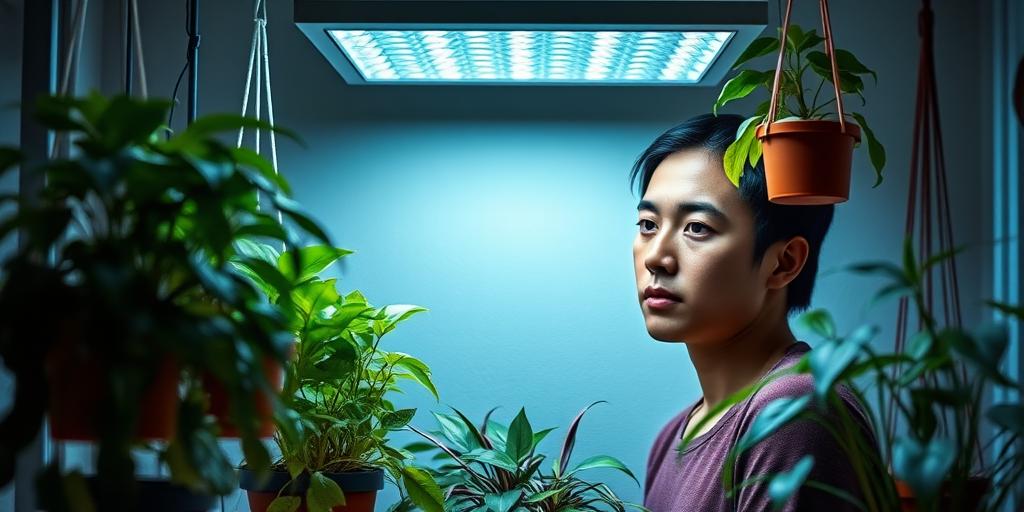
Grow Light Guide: Perfect for Low-Light Hanging Plants
Struggling with low-light hanging plants? Discover the best grow lights to keep them thriving! Learn about types, placement, and key features in this ultimate grow light guide.
Introduction
Do your hanging plants look a little sad? Low-light conditions can be tough on indoor greenery, but the right grow light can make all the difference! Whether you’re nurturing pothos, ferns, or spider plants, artificial lighting can mimic sunlight and boost growth. Did you know that plants under proper grow lights grow up to 25% faster? Let’s dive into the best solutions to keep your hanging plants lush and vibrant—even in the darkest corners!
Why Low-Light Hanging Plants Need Grow Lights
Common Challenges of Low-Light Environments
Hanging plants in dimly lit spaces often struggle to thrive. Without sufficient light, they may grow slowly, develop weak, leggy stems as they stretch toward any available light source, or show signs of yellowing leaves due to poor chlorophyll production. Some plants, like pothos or spider plants, can tolerate low light but won’t reach their full potential. Others, like string of pearls or hoyas, may stop growing altogether or drop leaves if conditions are too dark.
Benefits of Using Grow Lights
Grow lights provide a controlled light source that mimics natural sunlight, ensuring your hanging plants get the energy they need for photosynthesis. Unlike inconsistent window light, grow lights allow for year-round growth, even in winter or rooms with few windows. They also promote healthier foliage—brighter colors, denser growth, and stronger stems—making your plants more vibrant and lush.
Signs Your Hanging Plant Needs More Light
Watch for these red flags:
-
Leggy growth: Long gaps between leaves as the plant stretches.
-
Small or pale leaves: New growth is undersized or lacks vibrancy.
-
Leaf drop: Older leaves yellow and fall prematurely.
-
Slow growth: The plant seems “stuck” with no new development.
If you notice these issues, a grow light could be the solution.
Types of Grow Lights for Hanging Plants
LED Grow Lights
LEDs are a top choice for hanging plants due to their energy efficiency and customizable spectrum. Full-spectrum LEDs provide a balanced light range (similar to sunlight), promoting both vegetative growth and flowering. They emit little heat, reducing the risk of burning delicate trailing vines. Though pricier upfront, their long lifespan makes them cost-effective over time.
Fluorescent Lights
Great for beginners, fluorescent lights (like T5 or CFL bulbs) are affordable and effective for low-to-medium light plants. They produce a cooler light, making them safe to place close to foliage. However, they’re less energy-efficient than LEDs and may need replacement every 6–12 months.
Incandescent Bulbs
These traditional bulbs are cheap but inefficient for plant growth. They emit mostly red light (useful for flowering) but lack blue light, which is crucial for leafy growth. They also generate significant heat, risking leaf burn if placed too close. Best used as supplemental lighting in hybrid setups.
Hybrid Lighting Systems
Combining LEDs with fluorescents or incandescents can offer a broader spectrum. For example, pairing a cool-white fluorescent with a warm LED can balance growth and flowering phases. Hybrid setups are flexible but require more planning to avoid overcomplicating light placement.
Key Features to Look for in a Grow Light
Light Spectrum
-
Blue light (400–500nm): Encourages compact, leafy growth—ideal for ferns and pothos.
-
Red light (600–700nm): Supports flowering and fruiting, useful for hoyas or orchids.
Full-spectrum lights cover both ranges, making them versatile for most hanging plants.
Intensity & Coverage Area
Match the light’s strength to your plant’s needs:
-
Low-light plants (e.g., philodendrons): 100–300 µmol/m²/s.
-
Medium-light plants (e.g., string of hearts): 300–600 µmol/m²/s.
Check the light’s footprint to ensure it covers the entire hanging basket, especially if the plant trails downward.
Adjustability & Hanging Options
Look for lights with adjustable height (chains, pulleys, or telescopic arms) to maintain the optimal distance as plants grow. Clip-on lights work well for small setups, while overhead panels suit larger displays.
Energy Efficiency & Lifespan
LEDs last 50,000+ hours and use minimal electricity. Fluorescents last 10,000–20,000 hours but consume more power. Prioritize lights with high PAR (Photosynthetically Active Radiation) output per watt for the best efficiency.
Best Placement Tips for Grow Lights
Ideal Distance Between Light and Plant
-
LEDs: 6–12 inches away (low heat allows closer placement).
-
Fluorescents: 4–6 inches away (cooler but less intense).
-
Incandescents: At least 12 inches away (to prevent overheating).
Adjust if leaves show browning (too close) or stretching (too far).
Positioning for Trailing Plants
-
Overhead lighting: Covers the entire plant evenly; ideal for bushy growth.
-
Side lighting: Highlights trailing vines; use for plants like string of pearls.
Rotate the plant occasionally to ensure all sides receive light.
Using Timers for Consistent Light Cycles
Most hanging plants need 12–14 hours of light daily. A timer automates the schedule, preventing overexposure and mimicking natural day/night cycles. Smart lights with sunrise/sunset modes reduce stress by gradually adjusting intensity.
Top Grow Light Recommendations for Hanging Plants
Budget-Friendly Picks
-
Barrina T5 LED Grow Lights: Affordable, full-spectrum strips perfect for small setups.
-
GE Balanced Spectrum LED Bulb: Screws into standard fixtures; great for single plants.
Premium Full-Spectrum LED Panels
-
Spider Farmer SF-600: High PAR output for larger collections.
-
Mars Hydro TS 600: Dimmable and energy-efficient.
Clip-On Grow Lights for Small Spaces
-
LORDEM Grow Light: Adjustable gooseneck with timer; ideal for shelves.
-
Ankace 20W LED Clip Lamp: Compact and directional for targeted lighting.
Smart Grow Lights with Automation
-
Philips Hue White Ambiance: Programmable via app for customizable schedules.
-
Wyze Smart Bulb: Budget-friendly smart bulb with tunable white light.
Common Mistakes to Avoid with Grow Lights
Overexposing Plants to Light
Too much light causes bleached leaves, crispy edges, or wilting. Start with 10–12 hours daily and adjust based on plant response.
Choosing the Wrong Light Spectrum
Red-heavy lights may cause leggy growth in foliage plants. For ferns or pothos, prioritize blue or full-spectrum options.
Neglecting Maintenance
Dust on bulbs reduces light output. Clean fixtures monthly and replace bulbs as needed (fluorescents degrade over time even if they still emit light). Track usage hours to anticipate replacements.
Conclusion
With the right grow light, even the darkest corners can become a thriving oasis for your hanging plants! From choosing the best type to perfecting placement, this guide covers everything you need. Ready to transform your low-light plants? Start experimenting with grow lights today—your greenery will thank you!
